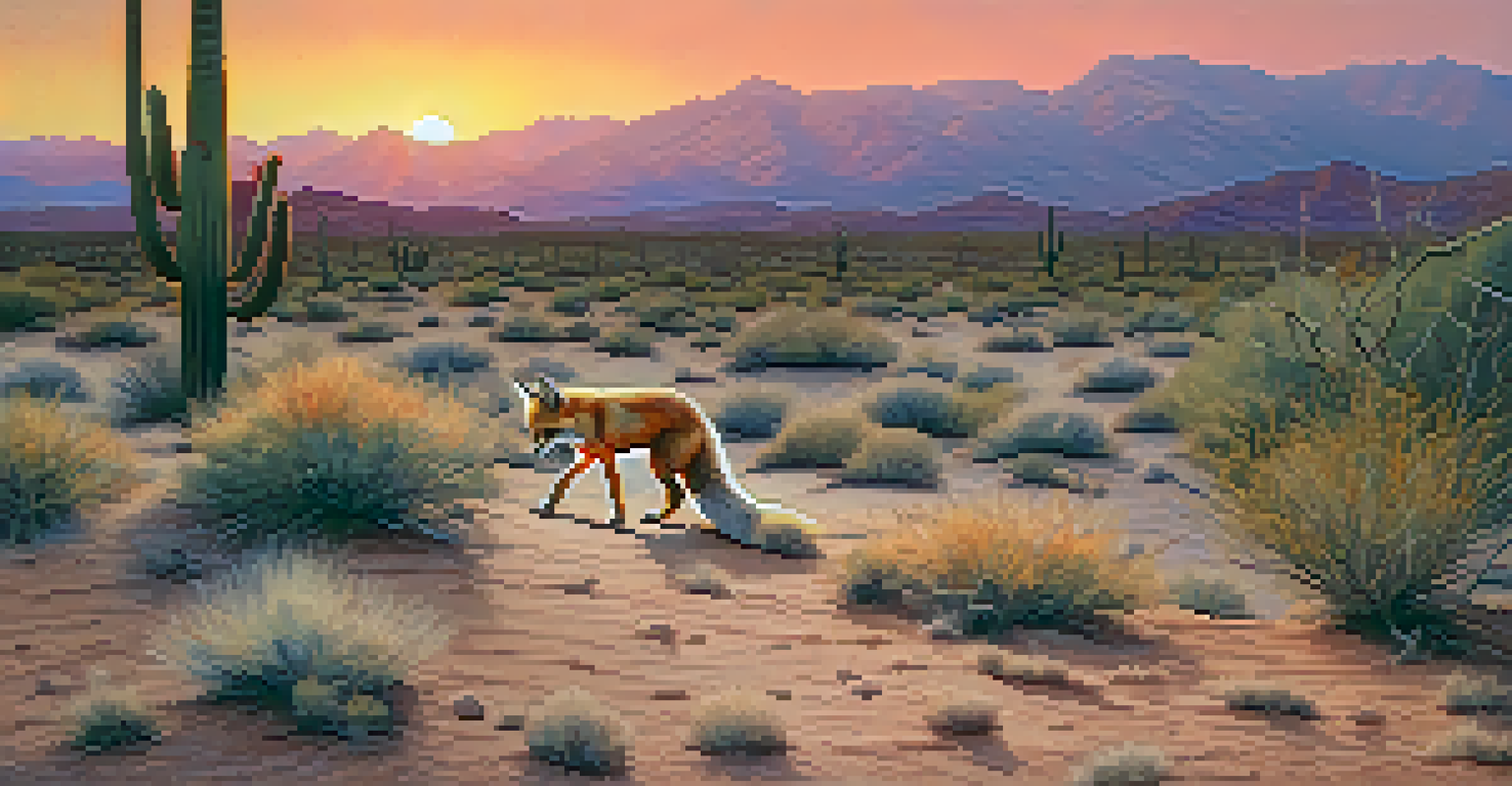Seasonal Changes: Wildlife Behavior in Tucson's Desert

Understanding Tucson's Unique Desert Ecosystem
Tucson's desert ecosystem is a vibrant tapestry of life, featuring a variety of species that have adapted to thrive in arid conditions. The Sonoran Desert, where Tucson is located, experiences distinct seasonal changes that greatly influence wildlife behavior. From the scorching summers to mild winters, every season brings unique challenges and opportunities for the local fauna.
In every walk with nature, one receives far more than he seeks.
During the warmer months, many animals become nocturnal to avoid the intense heat of the day. This shift in behavior allows species like the desert cottontail rabbit and various reptiles to conserve energy and stay hydrated. Understanding these adaptations is crucial for anyone interested in wildlife observation or conservation efforts in the area.
Related Resource
As temperatures drop in the winter, some species, such as certain birds and mammals, migrate or undergo behavioral changes to cope with the cooler climate. Studying these seasonal adaptations gives us insight into the resilience of wildlife and the delicate balance of desert ecosystems.
Spring Awakening: A Burst of Activity
Spring in Tucson is a time of renewal, where the desert comes alive with vibrant blooms and heightened animal activity. As temperatures rise and rain becomes more frequent, wildlife begins to emerge from their winter slumber. This season is particularly exciting for birdwatchers, as migratory birds return, filling the skies with their songs.

Many reptiles, such as rattlesnakes and lizards, emerge from hibernation, basking in the sun to warm their bodies. This is also the time when many mammals, like javelinas and coyotes, start to mate, leading to a new generation of young animals. Observing these behaviors can be a thrilling experience for nature enthusiasts.
Tucson's Wildlife Adapts Seasonally
Animals in Tucson demonstrate remarkable adaptations to thrive through the drastic seasonal changes of the desert ecosystem.
Spring also brings the blooming of wildflowers, which attract various pollinators, including bees and butterflies. The interconnectedness of these events highlights the importance of every season in sustaining Tucson's rich biodiversity.
Summer Survival: Adapting to the Heat
Summer in Tucson can be brutally hot, with temperatures often soaring above 100°F. To cope with this extreme heat, many animals adapt their behaviors significantly. Nocturnal activity becomes the norm, with creatures like the kit fox and the kangaroo rat venturing out only after sunset to forage for food.
The environment is where we all meet; where we all have a mutual interest; it is the one thing all of us share.
During the day, animals seek shelter in cool, shaded areas or burrow underground to escape the sun. These behavioral adaptations not only help them avoid dehydration but also reduce energy expenditure during the hottest parts of the day. It’s fascinating to see how wildlife ingeniously adapts to survive in such harsh conditions.
Related Resource
Moreover, some species, such as the desert tortoise, can go long periods without water, relying on moisture from the plants they consume. This incredible ability showcases the resilience and adaptability of desert wildlife in the face of seasonal challenges.
Monsoon Magic: A Time for Abundance
The arrival of the monsoon season in late summer dramatically transforms Tucson's desert landscape. With increased rainfall, the desert blooms, creating a lush environment that supports a surge in wildlife activity. This seasonal change not only replenishes water sources but also stimulates the growth of vegetation, providing food and shelter for many species.
Many animals take advantage of this abundance by increasing their foraging efforts. For instance, birds are often spotted feasting on insects, which thrive in the wet conditions. This period of plenty is crucial for many species, as they prepare for the drier months ahead.
Spring and Monsoon Bring Abundance
The arrival of spring and the monsoon season revitalizes Tucson's desert, leading to increased wildlife activity and food availability.
Additionally, the cooler temperatures that accompany the monsoon provide a welcome relief for both wildlife and residents. Observing the vibrant life that comes with the rains can be a rewarding experience, highlighting the interconnectedness of Tucson's ecosystems during this season.
Autumn Changes: Preparing for the Chill
As summer fades into autumn, Tucson's wildlife begins to prepare for the upcoming winter months. The temperatures drop, prompting many animals to shift their behaviors once again. This season is marked by increased activity as animals gather food and establish their territories before the chill sets in.
For many birds, autumn is a critical time for migration. Species like the American robin and various songbirds begin their long journeys to warmer climates. Observing these migratory patterns can be a fascinating aspect of wildlife watching during this time of year.
Related Resource
In addition, mammals such as the desert fox and the bobcat may start to bulk up before winter, taking advantage of the remaining food resources. The changing landscape signals a time of preparation, showcasing the instinctual knowledge that wildlife possesses to survive seasonal shifts.
Winter Wonders: Adaptation and Survival
Winter in Tucson can be mild compared to other regions, but it still presents challenges for local wildlife. Some species, like the desert bighorn sheep, thrive during this cooler season, as forage becomes more plentiful and temperatures are more manageable. The cooler climate often leads to increased visibility of these animals as they roam the mountains.
Many reptiles enter a state of brumation, a hibernation-like state, reducing their activity to conserve energy until the warmth of spring returns. Meanwhile, mammals may grow thicker fur to insulate against the cooler temperatures, showcasing their incredible adaptability to changing conditions.
Conservation is Key for Ecosystem Health
Active conservation efforts are essential to protect Tucson's diverse wildlife and their habitats amid seasonal challenges.
This season also brings opportunities for wildlife enthusiasts to observe unique behaviors, such as the courtship displays of certain birds. Understanding how animals adapt during winter helps deepen our appreciation for the resilience of Tucson's wildlife.
Conservation Efforts: Protecting Tucson's Wildlife
With the changing seasons and their impact on wildlife, conservation efforts in Tucson are vital. Organizations and local initiatives work tirelessly to protect the natural habitats that support the diverse species found in the area. Preserving these ecosystems ensures that wildlife can continue to adapt and thrive through seasonal changes.
Community involvement is crucial in these efforts. Residents and visitors can participate in wildlife monitoring programs, educational workshops, and habitat restoration projects. These activities not only foster a deeper connection with nature but also contribute to the overall health of Tucson's ecosystems.

By understanding the seasonal behaviors of wildlife, we can better appreciate the importance of conservation. Protecting these habitats is not just about preserving wildlife; it's about maintaining the balance of the intricate web of life in Tucson's desert.